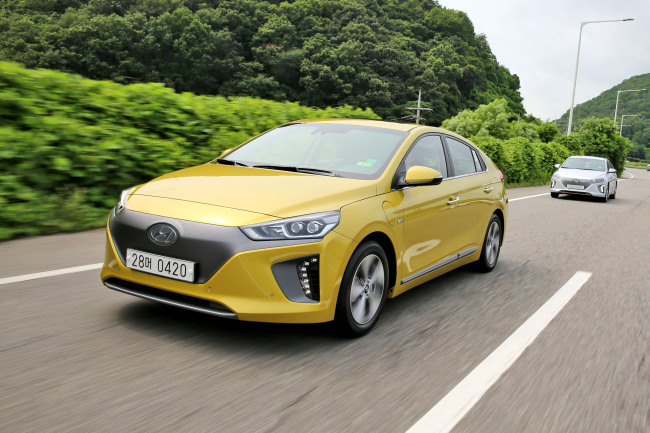[THE INVESTOR] Amid the growing popularity of hybrid cars among environmentally conscious drivers, Hyundai Motor has gone one step further with the pure electric car Ioniq Electric for those who want a more eco friendly option.
The nation’s largest automaker invited the press on Thursday to get behind the wheel, following a driving course based on the concept that an EV driver in Seoul traverses the city from east to west on diverse road conditions such as traffic jams and highways.
At a glance, the design of the electric vehicle is similar to its hybrid version, but it has no radiator grille -- ventilation to bring outside air to cool down the heated radiator in the car. Because the car runs on only batteries, it does not need an engine.

The exterior was not so sleek but the seats are reasonably comfy and there is enough storage space.
Upon starting the car, the dashboard displayed 191 kilometers in driving range and it fell to 175 kilometers when air-conditioning and music were turned on.
The driving experience of the car was tolerably pleasant, and better than expected, although not sensational. Even driving at a speed of more than 100 kilometers felt stable and comfortable. The instant torque delivery is much punchier than its hybrid car from a standing start and lower speeds.
Its drive mode offers a choice of Eco, Normal and Sport settings. Each mode provides different dashboard, air-conditioning system and regenerative braking system as if, the company said, a driver is experiencing three different cars.
When the mode was changed to Sport, there was a red hue to the dials and it offers more rapid acceleration with softer handling.
Regenerative braking -- which captures the car’s kinetic energy and pumps it back into the battery -- has also been set behind the steering wheel to allow drivers to ramp up the regeneration using paddles.
As for battery charging, the dashboard can show several nearby charging stations through a navigation map. In order to deal with the lack of charging stations, the automaker said it provides a home charger as well as one-stop consulting services such as installation and maintenance services for clients.
On behalf of clients, the employees from the consulting service deals with apartment building representatives, who gives approval to installing chargers at parking lots.
The Ioniq Electric costs 40 million won ($37,800) for the N-trim and 43 million won for the Q-trim. Generally, local buyers are able to purchase the vehicles at lower prices due to government subsidies that amount to around 20 million won.
By Shin Ji-hye (shinjh@heraldcorp.com)



![[Exclusive] Korean military set to ban iPhones over 'security' concerns](http://res.heraldm.com/phpwas/restmb_idxmake.php?idx=644&simg=/content/image/2024/04/23/20240423050599_0.jpg&u=20240423183955)



![[Herald Interview] 'Amid aging population, Korea to invite more young professionals from overseas'](http://res.heraldm.com/phpwas/restmb_idxmake.php?idx=644&simg=/content/image/2024/04/24/20240424050844_0.jpg&u=20240424200058)


![[Pressure points] Leggings in public: Fashion statement or social faux pas?](http://res.heraldm.com/phpwas/restmb_idxmake.php?idx=644&simg=/content/image/2024/04/23/20240423050669_0.jpg&u=)








